Demographics of Nepal
In the 2011 census, Nepal's population was approximately 26 million people with a population growth rate of 1.35% and a median age of 21.6 years.[1] In 2016, the female median age was approximately 25 years old and the male median age was approximately 22 years old.[2] Only 4.4% of the population is estimated to be more than 65 years old, comprising 681,252 females and 597,628 males. 61% of the population is between 15 and 64 years old, and 34.6% is younger than 14 years. In 2011, the Birth rate is estimated to be 22.17 births per 1,000 people with an infant mortality rate of 46 deaths per 1,000 live births. Compared to the infant mortality rate in 2006 of 48 deaths per 1000 live births, the 2011 IMR is a slight decrease within that 5-year period. Infant mortality rate in Nepal is higher in rural regions at 44 deaths per 1000 live births, whereas in urban regions the IMR is lower at 40 deaths per 1000 live births. This difference is due to a lack of delivery assistance services in rural communities compared to their urban counterparts who have better access to hospitals and neonatal clinics.[3] Life expectancy at birth is estimated to be 67.44 years for females and 64.94 years for males. The mortality rate is estimated to be 681 deaths per 100,000 people. Net migration rate is estimated to be 61 migrants per 100,000 people. According to the 2011 census, 65.9% of the total population is literate.[4]
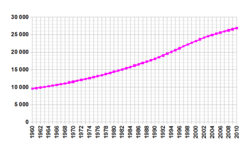
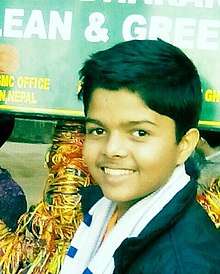
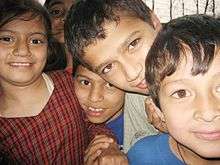
Population Growth
The population of Nepal has been steadily rising in recent decades. In the June 2001 census, there was a population of about 23 million in Nepal.[5] The population increased by 5 million from the preceding 1991 census; the growth rate is 2.3%.[5] The current population is roughly 30 million which contributes to an increase of about 3 million people every 5 years.
Sixty caste and linguistic subgroups have formed throughout time with the waves of migration from Tibet and India.[6] There was a moderate amount of immigration early in Nepal's history, then the population essentially remained the same without any significant fluctuations for over one hundred years.[6] Natural disasters and the following government resettlement programs in the 1950s led to a spike in internal migration from the hills to the Terai region.[6] In the 1980s the Western Chitwan Valley became a major transportation hub for all of Nepal. Along with this major change came a dramatic increase in government services, business expansion, and growing employment, especially in the agricultural industry. The valley's population grew rapidly through both in-migration and natural increase.[6]
Vital statistics
UN estimates
| Period | Live births per year | Deaths per year | Natural change per year | CBR1 | CDR1 | NC1 | TFR1 | IMR1 |
|---|---|---|---|---|---|---|---|---|
| 1975–1980 | 597,000 | 254,000 | 343,000 | 42.2 | 19.3 | 22.9 | 5.80 | |
| 1980–1985 | 651,000 | 253,000 | 398,000 | 41.2 | 16.9 | 24.3 | 5.62 | |
| 1985–1990 | 707,000 | 249,000 | 458,000 | 39.6 | 14.3 | 25.3 | 5.33 | |
| 1990–1995 | 767,000 | 244,000 | 523,000 | 37.2 | 11.6 | 25.6 | 4.97 | |
| 1995–2000 | 805,000 | 224,000 | 581,000 | 34.3 | 9.4 | 24.9 | 4.41 | |
| 2000–2005 | 797,000 | 201,000 | 596,000 | 29.7 | 7.8 | 21.9 | 3.64 | |
| 2005–2010 | 732,000 | 177,000 | 555,000 | 25.2 | 7.0 | 18.2 | 2.96 | |
| 2010–2015 | 20.9 | 6.5 | 14.4 | 2.32 | ||||
| 2015–2020 | 19.5 | 6.2 | 13.3 | 2.08 | ||||
| 2020–2025 | 18.1 | 6.1 | 12.0 | 1.93 | ||||
| 2025–2030 | 16.3 | 6.2 | 10.1 | 1.83 | ||||
| 2030–2035 | 14.5 | 6.3 | 8.2 | 1.76 | ||||
| 2035–2040 | 13.0 | 6.5 | 6.5 | 1.72 | ||||
| 1 CBR = crude birth rate (per 1000); CDR = crude death rate (per 1000); NC = natural change (per 1000); TFR = total fertility rate (number of children per woman); IMR = infant mortality rate per 1000 births | ||||||||
Source:[7]
Births and deaths[8]
| Year | Population | Live births | Deaths | Natural increase | Crude birth rate | Crude death rate | Rate of natural increase | TFR |
|---|---|---|---|---|---|---|---|---|
| 2011 | 326,725 | 129,978 | 196,747 | 11.4 | 4.5 | 6.9 | 2.52 | |
Structure of the population[9]
Structure of the population (22.06.2011) (Census) :
| Age Group | Male | Female | Total | % |
|---|---|---|---|---|
| Total | 12 849 041 | 13 645 463 | 26 494 504 | 100 |
| 0-4 | 1 314 957 | 1 253 006 | 2 567 963 | 9.69 |
| 5-9 | 1 635 176 | 1 569 683 | 3 204 859 | 12.10 |
| 10-14 | 1 764 630 | 1 710 794 | 3 475 424 | 13.12 |
| 15-19 | 1 443 191 | 1 488 789 | 2 931 980 | 11.07 |
| 20-24 | 1 043 981 | 1 314 090 | 2 358 071 | 8.90 |
| 25-29 | 917 243 | 1 162 111 | 2 079 354 | 7.85 |
| 30-34 | 770 577 | 964 728 | 1 735 305 | 6.55 |
| 35-39 | 740 200 | 864 119 | 1 604 319 | 6.06 |
| 40-44 | 660 290 | 725 831 | 1 386 121 | 5.23 |
| 45-49 | 575 101 | 597 858 | 1 172 959 | 4.43 |
| 50-54 | 505 864 | 499 612 | 1 005 476 | 3.80 |
| 55-59 | 412 892 | 405 371 | 818 263 | 3.09 |
| 60-64 | 368 451 | 388 376 | 756 827 | 2.86 |
| 65-69 | 277 782 | 276 667 | 554 449 | 2.09 |
| 70-74 | 199 610 | 195 543 | 395 153 | 1.49 |
| 75-79 | 117 358 | 117 777 | 235 135 | 0.89 |
| 80-84 | 62 787 | 65 990 | 128 777 | 0.49 |
| 85-89 | 25 810 | 26 716 | 52 526 | 0.20 |
| 90-94 | 8 940 | 11 395 | 20 335 | 0.08 |
| 95+ | 4 201 | 7 007 | 11 208 | 0.04 |
| Age group | Male | Female | Total | Percent |
|---|---|---|---|---|
| 0-14 | 4 714 763 | 4 533 483 | 9 248 246 | 34,91 |
| 15-64 | 7 437 790 | 8 410 885 | 15 848 675 | 59,82 |
| 65+ | 696 488 | 701 095 | 1 397 583 | 5,27 |
Life expectancy
| Period | Life expectancy in Years |
Period | Life expectancy in Years |
|---|---|---|---|
| 1950–1955 | 34.0 | 1985–1990 | 52.1 |
| 1955–1960 | 34.6 | 1990–1995 | 56.4 |
| 1960–1965 | 36.2 | 1995–2000 | 60.5 |
| 1965–1970 | 39.1 | 2000–2005 | 64.0 |
| 1970–1975 | 42.0 | 2005–2010 | 66.7 |
| 1975–1980 | 44.9 | 2010–2015 | 68.9 |
| 1980–1985 | 48.3 |
Source: UN World Population Prospects[10]
Demographic statistics
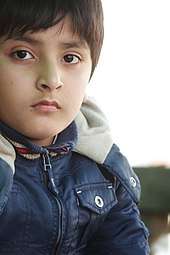
| Most Populous Caste/Ethnic groups (Census 2011)[11][12] | Population | % of total |
|---|---|---|
| Chhetri (khas) | 4,398,053 | 16.6% |
| Brahmin (Khas) | 3,226,903 | 12.2% |
| Magar | 1,877,733 | 7.3% |
| Tharu | 1,737,470 | 6.6% |
| Newar | 1,539,830 | 5.9% |
| Tamang | 1,321,933 | 5% |
| Sanyasi/Dasnami | 1,287,633 | 4.8% |
| Khas-Kami | 1,258,554 | 4.7% |
| Muslim (taken as a single religious group) | 1,164,255 | 4.4% |
| Yadav | 1,054,458 | 4.0% |
| Rai | 620,004 | 2.3% |
| Gurung | 522,641 | 1.9% |
| Sherpa | 472,862 | 1.8% |
| Thakuri | 425,623 | 1.6% |
| Limbu | 387,300 | 1.4% |
| Sarki | 374,816 | 1.41% |
| Teli | 369,688 | 1.4% |
| Chamar/Harijan/Ram | 335,893 | 1.3% |
| Koiri/Kushwaha | 306,393 | 1.1% |
| Musahar | 234,490 | 0.88% |
| Kurmi | 231,129 | 0.87% |
| Dhanuk | 219,808 | 0.82% |
| Dusadh/Pasawan | 208,910 | 0.79% |
| Damaii/Dholi | 112,946 | 0.42% |
| Sunuwar | 100,000 | 0.38% |
| 121,196 | 0.46% | |
| Other (more than 100 caste/ethnic groups) | 4,229,290 | 15.96% |
Nepal Demographic and Health Survey
Total Fertility Rate (TFR) (Wanted Fertility Rate) and Crude Birth Rate (CBR):[13]
| Year | CBR (Total) | TFR (Total) | CBR (Urban) | TFR (Urban) | CBR (Rural) | TFR (Rural) |
|---|---|---|---|---|---|---|
| 1996 | 37 | 4.64 (2,9) | 27 | 2.85 (1,9) | 38 | 4.83 (3,1) |
| 2001 | 33.5 | 4.1 (2,5) | 20.6 | 2.1 (1,4) | 34.9 | 4.4 (2,6) |
| 2006 | 28.4 | 3.1 (2,0) | 21.9 | 2.1 (1,4) | 29.5 | 3.3 (2,1) |
| 2011 | 24.3 | 2.6 (1,8) | 16.6 | 1.6 (1,2) | 25.5 | 2.8 (1,8) |
| 2016 | 22.4 | 2.3 (1.7) | 19.9 | 2.0 (1.5) | 26.3 | 2.9 (2.1) |
The following demographic statistics are from the 2011 Nepal Demographic and Health Survey (NDHS).[14]
Median birth intervals (Median number of months since preceding birth)
- Total: 36.2
- Rural: 35.9
- Urban: 40.3 (2011)
Median age at first birth
- Median age: 20.1 (2011)
Fertility rate - past trend and present
- Total fertility rate: 4.6 children born/woman (1996)
- Total fertility rate: 4.1 children born/woman (2001)
- Total fertility rate: 3.1 children born/woman (2006)
- Total fertility rate: 2.6 children born/woman
- Rural fertility rate: 2.8 children born/woman
- Urban fertility rate: 1.6 children born/woman (2011)
Ideal family size - Mean ideal number of children
- Overall (female/male): 2.1 / 2.3
- Currently married (female/male): 2.2 / 2.3
- Urban (female/male): 1.9 / 2.0
- Rural (female/male): 2.2 / 2.3 (2011)
Ideal family size by gender and age group
- Below is a table of the ideal family size by gender and age for 2011.
| Age | Women | Men |
|---|---|---|
| 15-19 | 1.9 | 2.2 |
| 20-24 | 1.9 | 2.1 |
| 25-29 | 2.1 | 2.1 |
| 30-34 | 2.2 | 2.3 |
| 35-39 | 2.3 | 2.4 |
| 40-44 | 2.5 | 2.4 |
| 45-49 | 2.6 | 2.6 |
CIA World Factbook
The following demographic statistics are from the CIA World Factbook, unless otherwise indicated.
Nationality
- Noun: Nepali, Nepalese
- Adjective: Nepali, Nepalese
Religions
- Hindu 81.34%, Buddhist 9.04%, Muslim 4.38%, Kirant 3.04%, other 2.2% (2011 census).
Literacy
- Definition: age 15 and over can read and write
- Total population: 48.6%
- Male: 62.7%
- Female: 34.9% (2001 census)
Population
- 29,033,914 (July 2016 est.)
Age structure
- 0-14 years: 30.93% (male 4,646,048/female 4,333,105)
- 15-24 years: 21.86% (male 3,176,158/female 3,169,721)
- 25-54 years: 35.99% (male 4,707,264/female 5,740,985)
- 55-64 years: 6.22% (male 877,288/female 927,202)
- 65 years and over: 5.02% (male 723,523/female 732,620) (2016 est.)
Median age
- total: 23.6 years
- male: 22.4 years
- female: 24.8 years (2016 est.)
Population growth rate
- 1.24% (2016 est.)
Birth rate
- 19.9 births/1,000 population (2016 est.)
Death rate
- 5.7 deaths/1,000 population (2016 est.)
Net migration rate
- -1.9 migrant(s)/1,000 population (2016 est.)
Total fertility rate
- 2.18 children born/woman (2016 est.)
Urbanization
- urban population: 18.6% of total population (2015)
- rate of urbanization: 3.18% annual rate of change (2010-15 est.)
Sex ratio
- at birth: 1.04 male(s)/female
- 0-14 years: 1.07 male(s)/female
- 15-24 years: 1 male(s)/female
- 25-54 years: 0.82 male(s)/female
- 55-64 years: 0.95 male(s)/female
- 65 years and over: 0.86 male(s)/female
- total population: 0.99 male(s)/female (2016 est.)
| CIA World Factbook Statistics | |
| Total Dependency Ratio | 61.4 |
| Youth Dependency Ratio | 52.5 |
| Elderly Dependency Ratio | 8.8 |
| Infant Mortality Rate (IMR) | 27.9 deaths/ 1,000 live births |
| Male IMR | 29.2 deaths/ 1,000 live births |
| Female IMR | 26.6 deaths/ 1,000 live births |
| Life Expectancy at Birth (total pop.) | 71 years |
| Life Expectancy at Birth (male) | 70.4 years |
| Life Expectancy at Birth (female) | 71.6 years |
Languages
Nepal's diverse linguistic heritage evolved from three major language groups: Indo-Aryan, Tibeto-Burman languages, and various indigenous language isolates. According to the 2001 national census, 92 different living languages are spoken in Nepal (a 93rd category was "unspecified"). Based upon the 2011 census, the major languages spoken in Nepal[16] (percentage spoken out of the mother tongue language) includes
Nepali (derived from Khas bhasa) is considered to be a member of Indo-European language and is written in Devanagari script. Nepali was the language of the house of Gorkhas in the late 18th century and became the official, national language that serves as the lingua franca among Nepalese of different ethnolinguistic groups. Maithili language—along with regional dialects Awadhi and Bhojpuri—are mother tongue Nepalese languages and spoken in the southern Terai Region. There has been a surge in the number and percentage of people who understand English. Majority of the urban and a significant number of the rural schools are English-medium schools. Higher education in technical, medical, scientific and engineering fields are entirely in English. Nepal Bhasa, the mother-tongue of the Newars, is widely used and spoken in and around Kathmandu Valley and in major Newar trade towns across Nepal.
Other languages, particularly in the Inner Terai hill and mountain regions, are remnants of the country's pre-unification history of dozens of political entities isolated by mountains and gorges. These languages typically are limited to an area spanning about one day's walk. Beyond that distance, dialects and languages lose mutual intelligibility. Since Nepal's unification, various indigenous languages have come under threat of extinction as the government of Nepal has marginalized their use through strict policies designed to promote Nepali as the official language. Indigenous languages which have gone extinct or are critically threatened include Byangsi, Chonkha, and Longaba. Since democracy was restored in 1990, however, the government has worked to improve the marginalization of these languages. Tribhuvan University began surveying and recording threatened languages in 2010 and the government intends to use this information to include more languages on the next Nepalese census.[17]
Religion
As of the 2011 census, 81.3% of the Nepalese population was Hindu, 9.0% Buddhist, 4.4% Muslim, 3.0% Kirant/Yumaist, 1.42% Christian, and 0.9% followed other or no religion.[18]
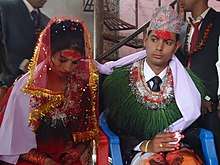
Nepal defines itself as a Secular nation according to Constitution of Nepal[19] It is common for many Hindus in the country to also worship Buddhist deities simultaneously with Hindu traditions. The notion of religion in Nepal is more fluid than other countries, particularly Western countries.[20] The Nepali people build their social networks through their religious celebrations, which are a central part to the whole of communities within the country.[19]
There is a general ideal held by the Nepalese people that there is an omnipotent, transcendental "moral order" that is sacred to Hinduism. This ideal exists along with the constant presence of chaos and disorder in the material world.[20] In the Northwestern region of the country, this all-encompassing state of disorder in the world is synonymous with human affliction, for which the religious Shamans can alleviate.[20] Shamans create a world of mythic time and space to restore order and balance to the world to cure the suffers.[20]
Kathmandu Valley is home to the Newars, a major ethnic group in Nepal. The city Bhaktapur is located inside of Kathmandu Valley. Bhaktapur was once an independent Hindu Kingdom.[20] Individual homes typically have at least one shrine devoted to personal deities, with an altar displaying flowers, fruit, and oil among other offerings to the Gods.[19] The perimeter of Kathmandu Valley is lined with shrines devoted to Hindu goddesses, whose purpose is to protect the city from chaotic events.In fact, at least one shrine can be found on the vast majority of streets in Kathmandu.[19] The people of Nepal do not feel the need to segregate or compete based upon religion, so Hindu and Buddhist shrines are often coexisting in the same areas.[19] The areas outside of the city are perceived to always possess some form of wild or disordered nature, so the Nepalese people inside of the city lines regularly worship the Hindu gods through public ceremonies.[20]
The Hindu god Vishnu symbolizes moral order in the Newar society. The natural human shortcomings in maintaining the godly moral order is represented by the Hindu god Shiva.[20] Shiva is destructive and acts in greed, and he threatens the moral order. In ancient myths, Vishnu must step in to contain Shiva and restore the order.[20] In recent times, there has been a rise in political violence, specifically Maoist violence.[19] This increased violence, along with the widespread poverty creates times of hardship for the people of Nepal. During their struggles they find stability and peace in religion.
Nepal's constitution continues long-standing legal provisions prohibiting discrimination against other religions (but also proselytization). The king was defied as the earthly manifestation of the Hindu god Vishnu. On May 19, 2006, the government faced a constitutional crisis, the House of Representatives which had been just reformed, having been previously dissolved, declared Nepal a "secular state".
However, the 2001 census identified 80.6% of the population as Hindu and 10.7% as Buddhist (although many people labeled Hindu or Buddhist often practice a syncretic blend of Hinduism, Buddhism, or animist traditions), 4.2% of the population was Muslim, 3.6% of the population followed the indigenous Kirat Mundhum religion and Christianity was practiced by 0.45% of the population.[21]
Buddhist and Hindu shrines and festivals are respected and celebrated by most Nepalese. Certain animist practices of old indigenous religions survive.
Ethnic and regional equity
Nepali was the national language and Sanskrit became a required school subject. Sanskrit was taught as a compulsory subject for grade 6 to 8 students before 2000. The Maoists, during the insurgency, were against the subject which was scrapped after they started attacking teachers who taught the subject. The subject is reintroduced after two decades when the education minister comes from the same Maoist party. [22] Children who spoke Nepali natively and who were exposed to Sanskrit had much better chances of passing the national examinations at the end of high school, which meant they had better employment prospects and could continue into higher education. Children who natively spoke local languages of the Madhesh and Hills, or Tibetan dialects prevailing in the high mountains were at a considerable disadvantage. This history of exclusion coupled with poor prospects for improvement created grievances that encouraged many in ethnic communities such as Madhesi and Tharu in the Tharuhat and Madhesh and Kham Magar in the mid-western hills to support the Unified Communist Party of Nepal (Maoist) and various other armed Maoist opposition groups such as the JTMM during and after the Nepalese Civil War. The negotiated end to this war forced King Gyanendra to abdicate in 2008. Issues of ethnic and regional equity have tended to dominate the agenda of the new republican government and continue to be divisive. Today, even after the end of a 10-year-old Maoist conflict, the upper caste dominates every field in Nepal. Although Newars are low in numbers, their urban living habitat gives them a competitive advantage. Thus, Newars are the toppers in Human Development Index. From a gender perspective, Newari women are the most literate and lead in every sector. Brahmins and Chhetris' women have experienced less social and economic mobility compared to Newari women. Specifically, Brahmin women experience less equality due to their predominately rural living conditions which deprives them of access to certain educational and healthcare advantages.[23][24][25][26][27]
Nepalese diaspora
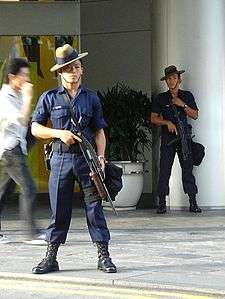
Nepalese in the U.K.
In the 2001 census, approximately 6,000 Nepalese were living in the UK.[28] According to latest figure from Office for National Statistics estimates that 51,000 Nepal-born people are currently resident in the UK.[29] There has been increasing interest in the opportunities offered in the UK by the Nepalese, especially education. Between the years of 2001 to 2006, there were 7,500 applications for student visas.[28]
Nepalese in Hong Kong
The Nepali people residing in Hong Kong are primarily made up of children of ex-Gurkhas; born in Hong Kong during their parents' service with the British Army's Brigade of Gurkhas, which was based in Hong Kong from the 1970s until the handover. Large groups of Nepali people can be found in Shek Kong and Yuen Long District off of the main bases of the British army. Many ex-Gurkhas remained in Hong Kong after the end of their service under the sponsorship of their Hong Kong-born children, who held right of abode.
Nepalese of middle age or older generations in Hong Kong are predominantly found in security, while those of younger generations are predominantly found in the business industry.
Mostly the people from Kirati ethnic groups such as Rai and Limbu are the ones residing in Hong Kong and other neighbouring nations such as Singapore and Japan
Nepalis overseas
Nepali migrants abroad have suffered tremendous hardships, including some 7,500 deaths in the Middle East and Malaysia alone since the year 2000, some 3,500 in Saudi Arabia.[30]
| Country | Articles | Population |
|---|---|---|
| Saudi Arabia | Nepalis in Saudi Arabia | 250,000 |
| Malaysia | Nepalis people in Malaysia | 6,175 |
| Qatar | Nepalis in Qatar | 200,000[31] |
| Japan | Nepalis in Japan | 80,038[32] |
| United Arab Emirates | Nepalis in the United Arab Emirates | 400,000 |
| United Kingdom[29] | Nepalis in the United Kingdom | 62,000 |
| Iraq[33] | 30,000 | |
| China | Nepalis in China | 21,000 |
| Portugal | 50,000 | |
| Hong Kong | Nepalis in Hong Kong | 16,000 |
| South Korea | Nepalis in South Korea | 22,015 |
| Singapore | Nepalis in Singapore | 4000 |
| Total Overseas Nepali Population | ~1,616,709 | |
Foreign population in Nepal
According to the 2001 census, there were 116,571 foreign born citizens in Nepal; 90% of them were of Indian origin followed by Bhutan, Pakistan and China.[34] This number does not include the refugees from Bhutan and Tibet.
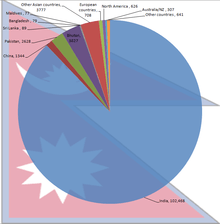
See also
References
- "National Population and Housing Census 2011 (National Report)" (PDF). Central Bureau of Statistics (Nepal). Archived from the original (PDF) on 18 April 2013. Retrieved 26 November 2012.
- "The World Factbook — Central Intelligence Agency". www.cia.gov. Retrieved 4 April 2017.
- Lamichhane, Reeta; Zhao, Yun; Paudel, Susan; Adewuyi, Emmanuel O. (1 January 2017). "Factors associated with infant mortality in Nepal: a comparative analysis of Nepal demographic and health surveys (NDHS) 2006 and 2011". BMC Public Health. 17 (1): 53. doi:10.1186/s12889-016-3922-z. ISSN 1471-2458. PMC 5223552. PMID 28068969.
- "Nepalese peoples and nationality law". The World Factbook. CIA. Retrieved 3 September 2016.
- "Population Growth Continues to Hinder Nepal's Economic Progress". www.prb.org. Retrieved 28 March 2017.
- Massey, Douglas S.; Axinn, William G. (August 2010). "Environmental change and out-migration: evidence from Nepal". Population and Environment. 32 (2–3): 109–136. doi:10.1007/s11111-010-0119-8. PMC 3042700. PMID 21350676.
- "World Population Prospects, the 2012 Revision". un.org. Archived from the original on 6 May 2011.
- http://unstats.un.org/unsd/demographic/products/vitstats/serATab3.pdf
- http://unstats.un.org/unsd/demographic/products/dyb/dyb2.htm
- "World Population Prospects – Population Division – United Nations". Retrieved 15 July 2017.
- "Nepal Demographics Profile 2014". IndexMundi. CIA World Factbook.
- "National Population and Housing Census 2011 (National Report)" (PDF). United Nations Statistics Division. United Nations Statistics Division.
- "MEASURE DHS: Demographic and Health Surveys". worldbank.org.
- "Nepal Demographic and Health Survey 2011" (PDF). Retrieved 7 May 2011.
- "South Asia ::NEPAL". CIA The World Factbook.
- "Official Summary of Census" (PDF). Central Bureau of Statistics, Nepal. 2011. Archived from the original (PDF) on 2 December 2012.
- Tumbahang, Govinda Bahadur (2010). "Marginalization of indigenous languages of Nepal". Contributions to Nepalese Studies. 37: 69 – via Expanded Academic.
- "2011 Nepal Census Report" (PDF). cbs.gov.np. p. 16. Archived from the original (PDF) on 18 April 2013.
- Ostrowski, Ally (2006). "THE FRAMING OF RELIGION". South Asian Popular Culture. 4 (1): 3–18. doi:10.1080/14746680600555410.
- Stone, Linda (2000). "Order, identity, and religion in Nepal". Reviews in Anthropology. 29 (1): 71–82. doi:10.1080/00988157.2000.9978248.
- Archived 9 April 2008 at the Wayback Machine
- https://kathmandupost.com/national/2020/05/17/government-decision-to-introduce-sanskrit-in-school-education-draws-controversy
- "OCHA Nepal – Situation Overview" (PDF). Issue 12. OCHA. April 2007. Archived from the original (PDF) on 13 November 2009. Retrieved 7 May 2011. Cite journal requires
|journal=(help) - "OCHA Nepal – Situation Overview" (PDF). Issue 16. OCHA. July–August 2007. Retrieved 7 May 2011. Cite journal requires
|journal=(help) - "OCHA Nepal – Situation Overview" (PDF). Issue 30. OCHA. June–July 2008. Archived from the original (PDF) on 18 February 2010. Retrieved 7 May 2011. Cite journal requires
|journal=(help) - Sharma, Hari (18 November 2010). "Body of murder victim found in Gulmi". Gulmi: The Himalayan Times online. Archived from the original on 25 May 2012. Retrieved 7 May 2011.
- Hatlebakk, Magnus (2007). "Economic and social structures that may explain the recent conflicts in the Terai of Nepal" (PDF). Kathmandu: Norwegian Embassy. Retrieved 8 May 2011.
- Jessica, Sims (2008). Soldiers, Migrants, and Citizens - Nepalese in Britain. Runnymede. p. 1. ISBN 978-1-906732-09-7.
- "Population by Country of birth and nationality Jan10-Dec10". Office for National Statistics. September 2011. Retrieved 17 September 2010.
- "'Natural deaths' raise doubts". ekantipur.com.
- "Qatar's population - by nationality". bq Magazine. Archived from the original on 23 April 2015.
- 【平成29年度末】在留外国人確定資料, 『在留外国人確定資料』 (PDF), Tokyo: Ministry of Justice, April 2018, archived from the original (PDF) on 27 March 2018, retrieved 13 April 2018
- "Nepal government lifts Iraq working ban". BBC News.
- Subedi, Bhim Prasad (2007). "The Issue of Foreign Born Population in Nepal: A Short Essay in Honor of Dr. Harka Gurung". The Himalayan Review. 38: 23–34.
![]()